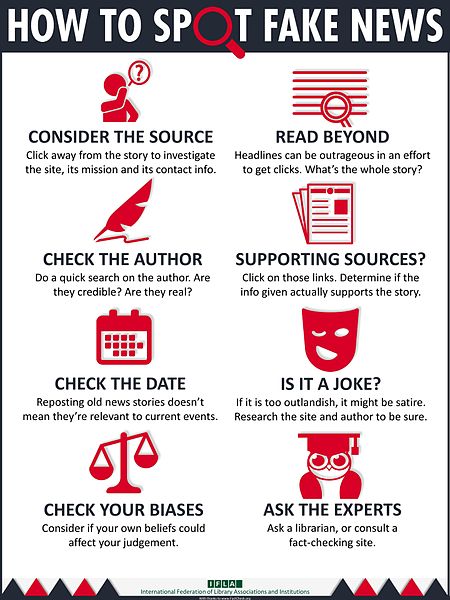6. Fake news, facts and data
Fake news
Fake news was declared Macquarie Dictionary’s Word of the Decade in 2021. Fake news is false information which is manipulated to confuse or fool people.
On 1 April every year, also known as April Fool’s Day, many normally reliable newspapers and news websites publish fake news to fool people. Try the ABC News’ “On April Fools’ Day, can you tell the real news headlines from the fake?” quiz for some examples.
Fake news and social media
Fake news is often spread through social media. It can be used to generate profit, as people click on links to find out more, or to further a particular agenda.
Bots
Bots are fake social media accounts generated by an automated service. The article – Meet ‘Sara’, ‘Sharon’ and ‘Mel’: Why people spreading coronavirus anxiety on Twitter might actually be bots – explains the potential danger of bots, discusses why it is done and lists indicators you can look out for, including:
- recently created accounts
- no followers
- no last names and alphanumeric handlers
- only a few posts.
Deepfakes
Deepfakes use machine-learning algorithms to create fake audio and video of real people. The technology is so sophisticated that it makes it very hard to know that it is fake. It is important that you evaluate the reliability of content that you see on social media because even when it looks real it might not be.
![]() Watch Fake News – and how to spot it (BBC video, 2m59s)
Watch Fake News – and how to spot it (BBC video, 2m59s)
News and satire
Writers or broadcasters sometimes use satire, including irony and dry wit, to parody or criticise public figures or to comment on current events. It is important to note that while satirical websites also create fake news items, the purpose is usually to entertain, rather than to mislead or manipulate. There are satirical news websites such as:
How to spot fake news
The Conversation reported that many young Australians are unable to identify fake news online.
If you are reading news items and are planning to use them in your assignments or social media, check the website where the ‘news’ is reported before you do. This BBC video on how to spot a hoax gives viewers tips on how to recognise fake news.
![]() Ask yourself the following questions:
Ask yourself the following questions:
- Has this story been reported by a reputable source such as the ABC, BBC, or The Guardian?
- Does the headline fairly reflect the contents of the news story, or is the headline purposefully sensational in order to get clicks (i.e. clickbait)?
- Who authored the news story? Are they credible?
- Is it a joke story? It may be satire reported as a true story.
- Have you checked a fact-checking website such as Snopes or Full Fact?
For more information, read Evaluating information.
![]() This infographic, produced by the International Federation of Library Associations and Institutions, outlines steps you can take to check if news is fake or not.
This infographic, produced by the International Federation of Library Associations and Institutions, outlines steps you can take to check if news is fake or not.

Screenshot: IFLA. How to spot fake news infographic. Retrieved September 18, 2018.
Alternative facts
Have you heard the phrase “alternative facts” in the news? “Alternative facts” are not actual facts, they are false and are disguised as truths to serve a person or groups’ own agenda.
True facts have been verified via research, experimentation and data collection. Some facts include:
- The world is not flat.
-
Items on Earth fall towards the floor due to the pull of Earth’s gravity.
-
The Great Pyramid of Giza is in Egypt.
In January 2017, Sean Spicer (then the White House Press Secretary) spoke at a press conference and told journalists that the crowd watching Donald Trump’s presidential inauguration was the largest in history. This was not true. U.S. Counselor to the President Kellyanne Conway spoke at a Meet the Press interview (YouTube, 3m53s) and, in defence of Sean Spicer’s comments, told the interviewer that Spicer was actually giving “alternative facts” when he spoke at the press conference.
Misleading data
‘There are three kinds of lies: lies, damned lies, and statistics.’ – attributed to Benjamin Disraeli by Mark Twain in Chapters from my Autobiography
Data and statistics are often used in news articles, debates, and scholarly articles with varying degrees of accuracy. Statistics are often used to persuade an audience of a fact. However, it is easy for statistics to be misleading, and this can be intentional or unintentional.
![]() Watch How statistics can be misleading (YouTube, 4m18s)
Watch How statistics can be misleading (YouTube, 4m18s)
Fact Check, an initiative of ABC News and RMIT University, has great analyses of the uses of statistics in the media, and is a great place to look for examples.
The Australian Bureau of Statistics has a guide to writing about statistics which is aimed at people writing policy, but is still applicable to your assignments.

